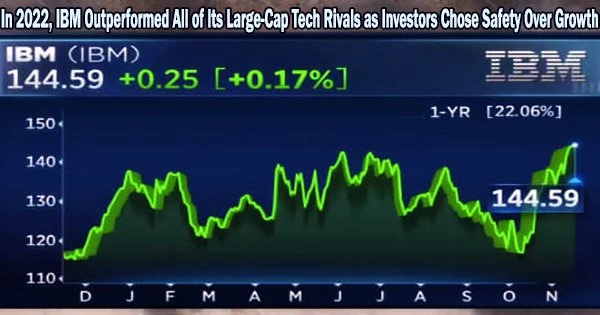International Business Machines Corporation (IBM) is a global technology company headquartered in Armonk, New York. IBM is known for its hardware, software, and consulting services, and it has a wide range of products and services that cater to businesses and consumers alike. IBM isn’t often described as a hot company. But in a year that saw investors abandon all major tech stocks, Big Blue was in the green.
The Nasdaq is closing out its worst year since 2008. Growth companies have been penalized and more established, less volatile names that are thought to be more recession-resistant have been rewarded as a result of high gas costs, skyrocketing inflation, and the Federal Reserve’s steady pace of rate hikes.
As the economy recovered and customers reverted to many of their old behaviors, tech companies that had prospered during the Covid era suffered the most.
Among U.S. tech companies valued at $50 billion or more, IBM is one of only two to generate positive returns so far in 2022. As of Friday’s close, the stock was up 6% for the year. The other gainer is VMware, which is up 5% because it agreed in May to be acquired by Broadcom for $61 billion.
Investors turned to 111-year-old IBM, betting on its solid profitability, alongside energy stocks like Exxon Mobil, health-care brands like Merck, and industrials Northrop Grumman and Lockheed Martin, while Meta, Amazon, and Tesla were pounded.
IBM is “trading well above its historical range,” Bernstein Research analysts wrote in a Dec. 20 note to clients. The firm has a hold rating on the stock.
Nobody will mistake IBM for a growth stock. Expansion is consistently in the single digits, and last year the company spun off Kyndryl, its managed infrastructure services business, into a separate publicly traded entity. That cut head count by about 90,000.
However, IBM’s free cash flow in the most recent quarter increased by 25% from a year earlier to $752 million, and it distributed $1.5 billion in dividends. Earnings and revenue for the third quarter exceeded expectations, and the corporation increased its annual outlook.
Crawford Investment Counsel in Atlanta, which focuses on income and dividends, looked at IBM in 2016 and concluded that it would be too early for a major investment, said Aaron Foresman, an equity analyst at the firm.
‘Much closer to their vision’
Crawford’s thesis changed in 2019, after IBM bought faster-growing Red Hat for $34 billion. The firm, which today has $6.7 billion under management, boosted its IBM stake from $2 million to $30 million and kept buying until its holdings reached $109 million.
IBM took a hybrid approach to the cloud under CEO Arvind Krishna, who succeeded Ginni Rometty at the helm in 2020. The company staked that businesses would combine the public cloud with on-premises data center infrastructure rather than relying solely on one strategy after struggling to grow as a cloud infrastructure provider.
“Three years later, it’s much closer to their vision than everything on public cloud,” Foresman said. His firm sold 3% of its shares in the second and third quarter of this year.
Consulting remains a huge part of IBM’s business, accounting for one-third of revenue. In that realm, IBM partners with the big cloud providers, rather than strictly competing with them. The company has a backlog of business with Microsoft worth more than $1 billion, and an even bigger one with Amazon, Krishna said in a conversation with RBC CEO Dave McKay in November.
IBM also made technological advances in 2022, introducing the z16 mainframe computer. When a new mainframe hits, many clients upgrade. That leads to greater hardware revenue and highly profitable transaction processing software to run on the machines. IBM’s prior mainframe boom cycle started in September 2019.
This year, IBM avoided making any big, expensive purchases, but it did make a few smaller deals to improve specific skills. Earlier this month, IBM and Virginia-based Octo reached an agreement to merge. Octo specializes in consulting for government organizations. Terms weren’t disclosed. It also absorbed consulting companies Dialexa and Sentaca this year.
Foresman described the purchases as an appropriate use of capital and “so small that they’re not necessarily disclosing transaction multiples.”
Still, Krishna recognizes that the economic backdrop isn’t ideal. He said in October that higher prices have led to “some caution creeping into the conversations” in Europe, where the company has to prepare for a downturn. In the Americas, where IBM gets about 53% of revenue, the business climate is “very robust,” he said.
The trajectory of the stock from here may simply depend on the status of the economy rather than any significant event occurring within the company, according to Bernstein analysts.
“Given its defensive characteristics and historical performance, we believe that IBM is likely to fare well if we continue to have pressured markets, and likely to lag major indices if we enter a recovery period,” they wrote.
IBM’s model through 2024 calls for mid-single-digit revenue growth, translating into free cash flow growth in the high single digits.
That’s good enough for investors who look for safety in their equity bets.
“Combined with mid-single-digit revenue growth, a couple points better than that on EPS and a 5% dividend yield is you know, that’s not a home run, but it’s well within our expectations for what we’re trying to accomplish,” Foresman said.
















